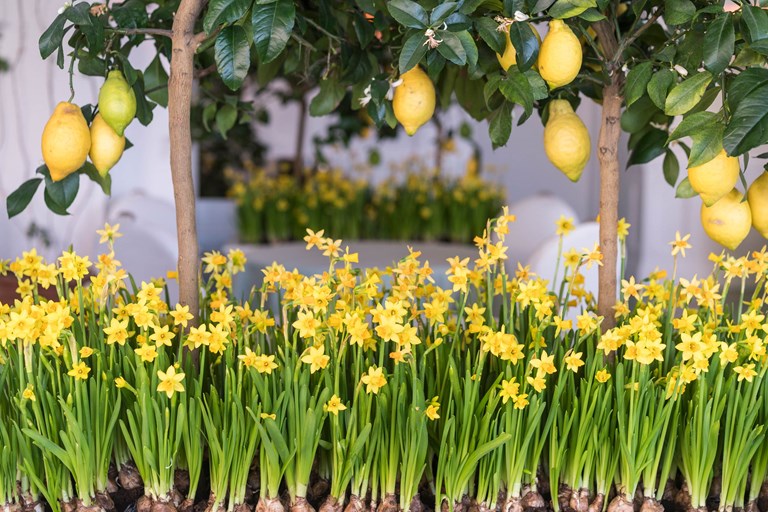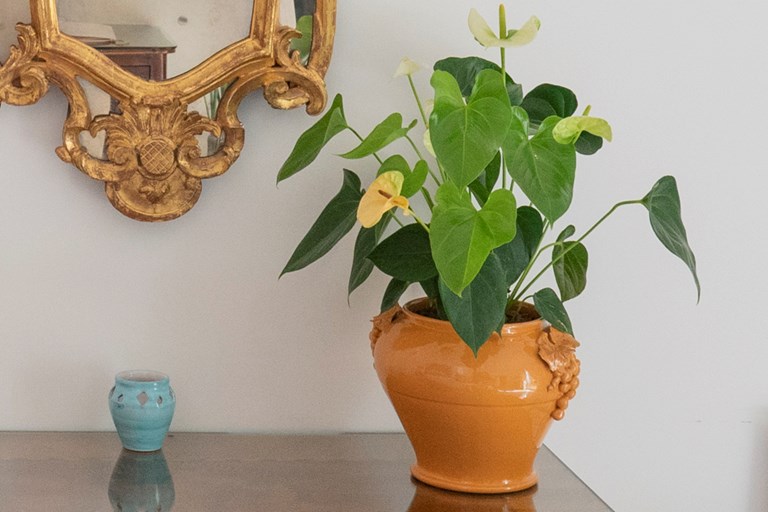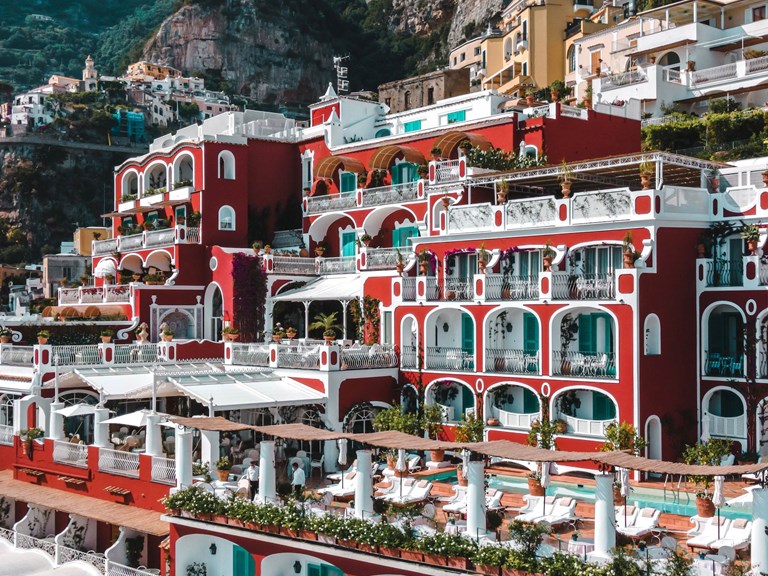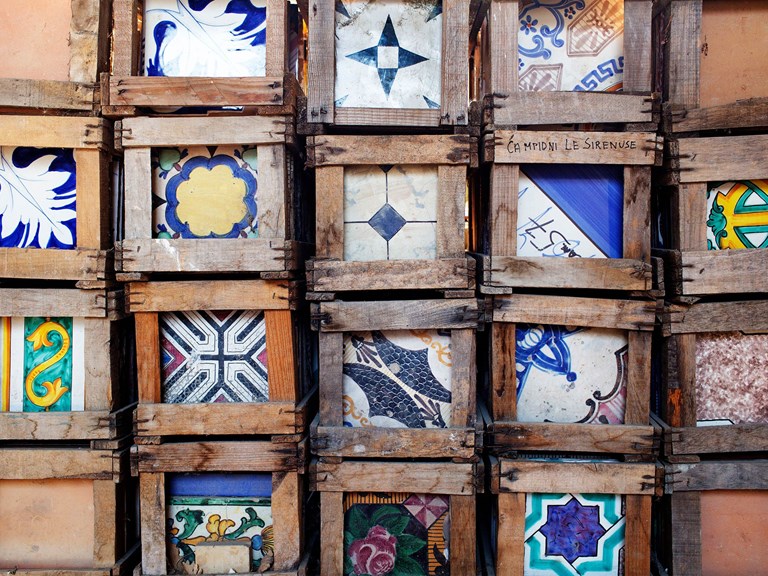FIVE PLANTS TO LOVE DURING LOCKDOWN
30.03.2020 LE SIRENUSE
In other words, even as the worst pandemic of the 21st century threatens our health and restricts our movement, fruit trees are bursting into bloom, asparagus spears are pushing their heads above ground, orchids and magnolia flowers are unfurling – while in the southern hemisphere, forests are turning russet gold and the wine harvest is in full swing.
Nature’s steady course reminds us that everything is cyclical and that, in the end, to quote an even more popular hashtag that’s trending in Italy right now, #andràtuttobene – everything will be alright. But there’s more than comforting maxims to be gleaned from the plant kingdom. Gardening is therapeutic even in normal times, all the more so when you find yourself self-isolating in a city apartment with little or no outside space.
Le Sirenuse is famous for its outdoor and indoor plants, from the lemon trees that frame the pool to the bougainvillea that climbs the walls and meanders over the ceiling of La Sponda restaurant. One magnificent specimen, the Strelitzia nicolai (giant white bird of paradise plant) at the foot of the stairs that lead down from the lobby, even inspired a site-specific work of art, Alex Israel’s mural Amalfi Dr., 2017, part of the hotel’s ongoing Sirenuse Art Projects initiative.
We figure that there has never been a better time to share a little gardening advice with all our friends around the world. The Sirenuse Journal is grateful, therefore, to the hotel’s plant curator Giulia Sersale, who in collaboration with Le Sirenuse’s head gardener, Nello Trapani, has chosen five of her favourite indoor specimens from among the many to be found inside the hotel.
Medinilla magnifica (Rose Grape)
We love this beautiful plant, which is native to the Philippines. Our guests can admire the drooping clusters of pink flowers on the table in our lobby, in our bars and in our corridors.
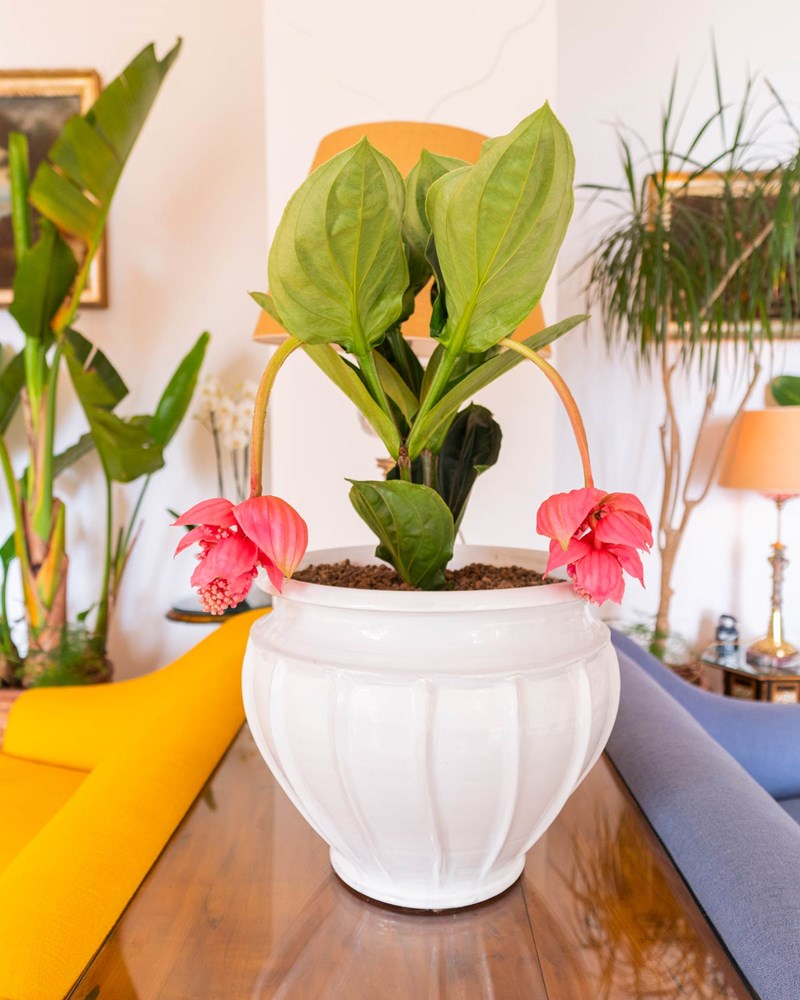
Commonly known as the Philippine orchid, Medinilla is an epiphyte, in other words a plant that grows on other trees but doesn’t draw nutrition from those trees as parasites do. In the tropics it is grown as a perennial, while in cooler climes, it is a common house plant. King Baudouin of Belgium was a big Medinilla devotee. He grew them in the royal conservatories, and they were even depicted on Belgium’s 10,000-franc bank note. The plant’s Latin name pays homage to José de Medinilla y Pineda, who was governor of Mauritius (then known as the Marianne Islands) in the early nineteenth century.
Plant care
- The potted Medinilla magnifica plant needs to be placed in a bright room with plenty of sunlight.
- Keep the plant away from cool draughts from doors or windows. Draughts will increase water loss and may contribute to leaf drop.
- Let the soil dry out well between watering to avoid root diseases. Medinilla should be watered less often in the winter when the plant's growth slows. Remember, this plant is an epiphyte and is not used to having constantly wet roots.
- Indoors, Medinilla thrives in a humid environment. It will need to be misted frequently or grown in a room with plenty of humidity. The bathroom is a perfect place for your tropical beauty, providing there is enough natural light. You can also set the pot and base on a tray of pebbles immersed in water, which will slowly release moisture.
- Feed every two weeks spring through fall with fertilizer commonly used for flowering plants.
Orchids
One of the largest of all plant families, Orchidaceae takes in around 28,000 species – that’s more than double the number of known bird species, and four times the number of mammals.
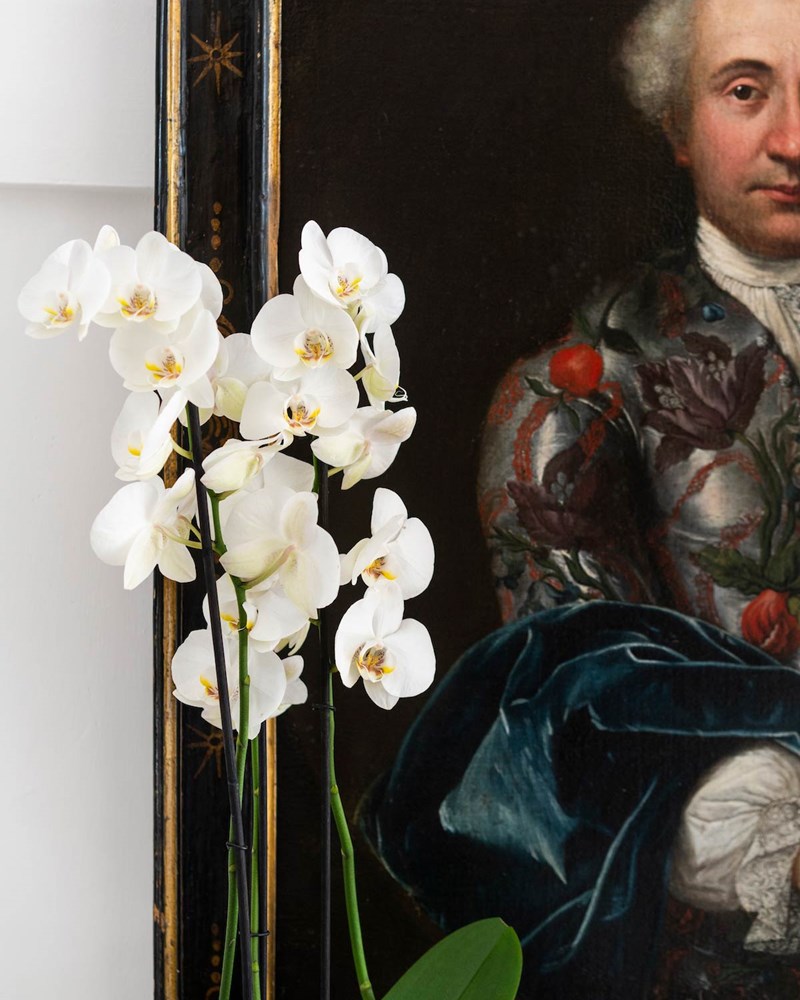
They are among the most loved of all indoor plants, with many nurseries, enthusiasts and societies around the world focusing solely on orchids and the many hybrids and cultivars that have been created over the centuries. Although associated with modern horticulture, orchids have been admired for centuries. The earliest known depiction of the flowers in European art appears amidst the stone carvings of the Ara Pacis, an altar erected in Rome by the emperor Augustus in 9BC.
Orchids have long been an important part of Le Sirenuse’s indoor planting scheme. Among the species we love are Phalaenopsis, Miltonias, Oncidiums, Cambrias and Dendrobiums. These beautiful, decorative plants live happily indoors.
Plant care
- Orchids thrive in strong light, but not in direct sunlight (though Dendrobiums can handle more sun). They also need high humidity and airflow around their roots, and regular periods of drying alternated with heavy watering.
- One trick with watering orchids is to submerge the pot in a basin or sink full of water for 8/10 minutes, then let the water out of the sink and allow the roots to drain off. This watering should be done once every 8/10 days.
- Orchids do best in temperatures above 50°F (10°C) and below 85°F (30°C).
- During the growing season, feed orchids weekly with a weak solution of a powder or liquid fertilizer.
- In the winter, keep your plant warm and reduce watering to once a month or so. Mist it every now and then to make sure it stays hydrated. There’s no need to feed it.
- If you see signs of yellowing or wrinkled leaves, or if it fails to bloom, move your plant to another place in your room. Orchids need to find their happy spot: when they do, they’ll continue blooming for a long time.
- Orchids are ‘social plants’ and love being close to other plants, so if you have more than one orchid, place them close together on a table or a shelf, leaving a little space between them.
Ferns
There is one plant at Le Sirenuse that we consider to be the mother of all the others: the beautiful Nephrolepis exaltata fern (also known as the sword or Boston fern) that dominates the third-floor bar lounge beneath Martin Creed’s neon artwork Don’t Worry.
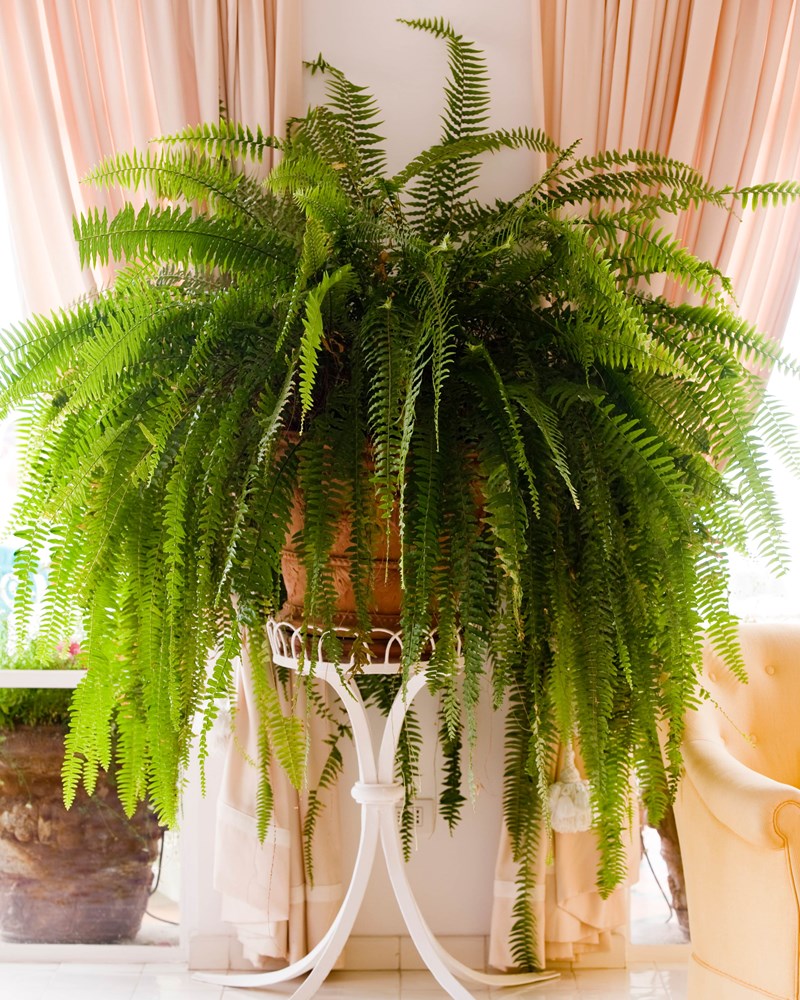
Looking like one of Tina Turner’s more extravagant hairstyles, she grows in a terracotta pot between the two French doors that lead out onto the pool terrace. She was placed there by our late aunt, Anna Sersale, who had a great passion for plants and curated all our terraces and common areas. I was honoured to take over her role after she passed away in 2004.
Plant care
- Ferns are relatively easy to grow; however, drafts, dry air and temperature extremes won’t help.
- Some ferns are native to more temperate climates and are well suited to cooler parts of houses but won’t survive in rooms that are over-heated. Tropical ferns survive best in homes with central heating.
- All ferns love moisture and should be kept in humid conditions. Stand their pots on trays of damp pebbles or clay granules. Ferns also love being misted at regular intervals with soft, tepid water; alternatively, keep the whole room humid by using a humidifier.
- It is important to provide the right compost. Most ferns are forest or woodland plants and have tender, delicate roots adapted to light forest soil, which is rich in leaf mould and decaying vegetable matter. The compost must be free-draining so that the roots never get waterlogged. A compost that contains peat or a fibrous peat substitute with plenty of sand is best. The compost should never be allowed to dry out. In a warm dry atmosphere this may mean watering the plant a little every day.
- Place your ferns near a window that gets morning or late afternoon sun, and keep them away from strong sunlight, especially during the summer. Direct sunlight will make them lose their leaves or turn their fronds yellow. You can keep your ferns in dim light as long as you give them regular breaks in bright light. They can be given artificial light, but this should be from a special gardening bulb or fluorescent strip.
- In summer feed your ferns every two to four weeks with a liquid fertilizer, but don’t mix it full strength because you can damage the root system. Just a few drops of fertilizer can be added to the water occasionally for misting. Don’t feed your ferns in winter when they’re resting.
Bougainvillea
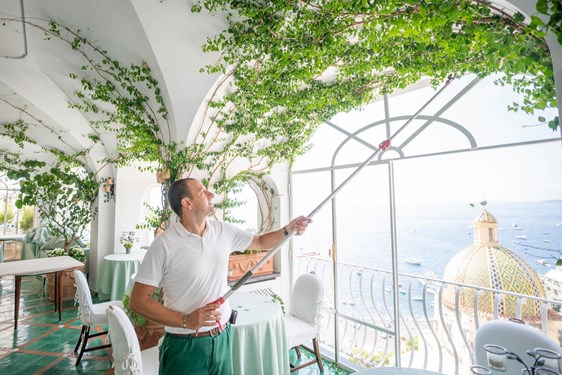
View
This beautiful Bougainvillea glabra sanderiana will be familiar to so many of those who have lunched or dined in our La Sponda restaurant, where it climbs up the walls and across the vaulted ceiling in long tendrils. It’s a vigorous climber that produces glossy green foliage and stunning magenta bracts during summer and autumn. It is the easiest bougainvillea to grow indoors, making it a popular house plant not only at Le Sirenuse but throughout Positano and the Amalfi Coast.
Plant care
- Plant your bougainvillea in a large terracotta pot with drainage holes.
- It needs at least four hours of direct sunlight a day to bloom.
- Water thoroughly then allow the top two inches (5cm) of soil to dry out before watering again. Overwatering will cause the leaves to turn yellow and fall off. Keep it slightly drier in winter.
- Climbing bougainvilleas like high humidity during the summer growing season
- A 50% humidity level around the plant is recommended: a cool mist room humidifier is a good idea.
- It thrives in average to warm temperatures, from 60 to 80°F (16-27°C).
- These are frost-tender plants that hate the cold, so place them as close as you can to south/west facing walls inside your home.
- Bougainvillea plants can grow up to 15 ft (4.5 m) high, but can also be grown as bonsais, with frequent pruning.
At Le Sirenuse, we love our decorative red anthuriums, with are the perfect match for corridors with low natural light levels, and our white anthuriums, which are an elegant presence in many of our guest rooms. Beware that all parts of anthuriums are poisonous and may cause mild stomachache if ingested.
Plant care
- Anthuriums are relatively easy to care for. They can tolerate all levels of indirect light, however those growing in particularly low light will have fewer flowers and grow more slowly. Bright, indirect light is recommended.
- Their optimal temperature range is 61 to 72 °F (16–22 °C)
- The soil should be free-draining but hold some water. Make sure never to overwater however, as these plants are susceptible to root rot.
- The recommended soil is a blend of orchid compost and perlite and potting soil.
Le Sirenuse Newsletter
Stay up to date
Sign up to our newsletter for regular updates on Amalfi Coast stories, events, recipes and glorious sunsets
